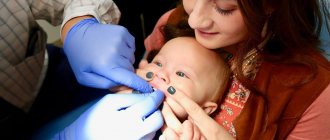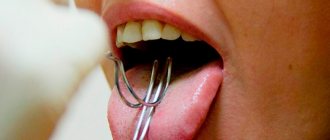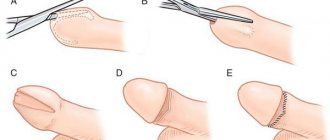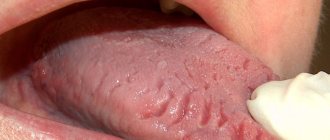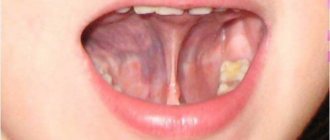Symptoms and clinical picture of a short frenulum of the tongue in a child
Signs of a short frenulum may not be noticed by inexperienced parents or those who do not know about this pathology; usually the problem is identified by nurses and doctors in the maternity hospital. The characteristic manifestations of ankyloglossia are as follows:
- when trying to stick out the tongue, it takes an arched position;
- when the tongue is raised, the frenulum is tensioned, as a result of which the body of the organ takes on the appearance of a heart;
- the tongue is fixed at the bottom of the oral cavity and cannot fully “come out” out.
Since the symptoms of a short frenulum of the tongue in a child are not obvious, you should pay attention to the following nuances.
In the first year of life, problems arise when breastfeeding. The child cannot properly grasp the nipple with his lips, squeezes it excessively with his gums, or bites it. This leads to malnutrition, hence anxiety and frequent crying.
Later, irregular teething may occur, with displacement or initial malocclusion.
At the time of speech development, difficulties are also noted; the child has difficulty pronouncing hissing and upper articulation sounds, and may burr.
At a later age, frequent and very painful tears of the shortened ligament are added to the described troubles.
Short frenulum of the tongue
This is a manifestation of congenital pathology of the facial area. Which manifests itself in the insufficient length of the ligament that connects the lower oral cavity to the tongue. At the same time, a short frenulum limits the movements of the tongue; the shorter the frenulum, the more discomfort and difficulties it causes. A short frenulum occurs 3 times more often in boys than in girls.
The condition of the oral cavity in a small child plays not only great importance in nutrition, but also in the development of correct speech, in the formation of appearance and a beautiful smile.
The most common cause of this developmental anomaly is considered to be a hereditary factor. So, if one of the parents has a short lingual frenulum, in 90% of cases, the pathology will also be present in the child.
In most cases, this birth defect is diagnosed in the first days of a baby’s life. If this has not been done, then parents may be alerted to a number of symptoms.
One of the very first signs that mothers notice immediately after birth is problems with breastfeeding. As practice shows, 25% of children with a short frenulum of the tongue cannot grasp the breast normally. If the baby manages to do this, he quickly gets tired and subsequently refuses to breastfeed. During feeding, the child becomes restless and capricious. The only way out if the baby does not latch onto the nipple correctly and does not receive enough milk is to switch to artificial feeding. It is easier for such children to adapt to the nipple on the bottle. There are cases when a child with a short frenulum of the tongue can attach normally to the breast and be completely saturated. But this fact does not guarantee that the developmental anomaly will not make itself felt in the future.
At an older age, children with a short frenulum develop a number of disorders of the speech apparatus. The child has difficulty articulating and pronouncing some consonants correctly. As a result, speech becomes blurred and incomprehensible. This problem requires constant sessions with a speech therapist. In addition, at an older age it is possible to develop many complexes that are associated with an irregular tongue shape. Cases can be serious and require therapy from a child psychologist.
Diagnostics
Cases when a child cannot stick the tip of his tongue beyond the teeth or lick his upper lip are considered serious and require surgical intervention. For a more accurate diagnosis, doctors resort to the E. Haselbaker test. In infancy and preschool age, indications for surgery are cases when the child experiences significant difficulties during feeding, when there is obvious deformation or the formation of a pathological bite.
Preparing for surgery
Surgical intervention for a short frenulum of the tongue is carried out after standard preoperative preparation, which is aimed at:
- assessment of general health;
- identification of possible contraindications;
- prevention of intra- and postoperative complications.
The operation is performed under general anesthesia using local anesthesia. The psychological preparation of the child is also important: explain to the child that the operation is necessary for his health, and we will provide the most comfortable conditions for his stay in the clinic.
In the case of an operation under general anesthesia, a standard preoperative examination is performed. An examination plan for the child before the operation; if local anesthesia is planned, then we carry out a preoperative examination before a minor surgical intervention. An examination plan for the child before a minor surgical intervention (nevus, granuloma, etc.).
Operation
With a short frenulum of the tongue, a simple operation is performed in which it is trimmed - dissected (frenulotomy).
Rehabilitation period
After surgery, the child should spend 3–6 hours in the hospital under the supervision of a doctor. The postoperative period proceeds without pain. After surgery, it is important to follow special hygiene rules, which our doctor will explain in detail. Full recovery usually takes no more than 10 days.
Forecast
With timely detection and treatment of the disease, the prognosis is very favorable. The treatment itself usually takes place quite quickly and easily, after which patients, as a rule, do not even remember that they had this problem.
Cost of surgery for short frenulum of the tongue (frenulotomy):
- under local anesthesia RUB 1,155.
- under general anesthesia RUB 5,775.
Basic treatment methods and contraindications
Ideally, dissection of the frenulum should be performed in the first days of the child’s life, but there are 2 options for the development of events.
In infancy, the incision is made by a surgeon using scissors, which at this stage of life is absolutely painless, since there are still no nerve endings in this area. After this, the baby is applied to the breast in order to calm and prevent the development of bleeding.
How to treat a short frenulum of the tongue in older children? Also, the operation will only be more painful, since the membrane thickens over the years. Typically, frenuloplasty is performed - transfer of the site of fusion of the frenulum, followed by suturing.
Get frenuloplasty from a genital surgeon
Advantages of frenuloplasty As a result of frenuloplasty, the frenulum lengthens, becomes strong and elastic. Pain, discomfort and risk of tearing disappear. Only in 10% of men the problem persists and they require complete removal of the foreskin with the formation of a new frenulum. Does frenuloplasty affect urination, erections or fertility? If the procedure is performed correctly, there is no risk to erection, urination or reproductive function. On the contrary, the man’s quality of life improves. He feels confident, gets rid of anxiety and unpleasant sensations.
How long does it take to abstain from sex after frenuloplasty? 7-10 days.
When can I return to sports after surgery? You can return to fitness the next day if you do not feel weakness or pain. To contact and heavy sports after complete healing of the wound.
Anesthesia To perform frenuloplasty, local anesthesia is used. The patient remains conscious, does not feel pain and can go home an hour after the procedure. None of the patients complained of pain during the procedure.
The essence of frenuloplasty is to cut the frenulum transversely and then stitch it along its length. The suture is made with absorbable material, which is used in facial plastic surgery. The suture technique is strictly controlled by a doctor using surgical glasses with magnification. The suture and wound are sealed with surgical glue at the end of the entire operation. It prevents bacteria from entering this area, and also additionally holds the tissues together. Minimizes the risk of wound infection and suture dehiscence.
The whole procedure takes place very quickly – 10-20 minutes.
You can shower 24 hours after surgery. There is no need to specifically soap or rub the wound, just let the soapy water roll over it. Do not dry the wound with a towel. Allow it to air dry without wearing underwear, or blot with a sterile paper towel.
The day after frenuloplasty, you can return to work if it does not involve heavy physical labor and high activity. Otherwise, a 2-3 day rest is necessary. Many patients choose Friday or Saturday for the procedure to allow for recovery time ahead.
During the first 48 hours, small drops of blood may be released. The use of surgical glue reduces such cases to almost 0, but if this happens: a few drops, this is the norm. Apply a sterile cloth, apply light pressure and observe the wound.
During the first day, swelling or a small hematoma may persist.
As we have already written, frenuloplasty does not affect urination in any way, so there should be no problems with this either in the first or subsequent hours after the operation. An erection can cause pain until the wound has healed, so use behavioral methods to reset an erection (get distracted, think about something unpleasant, apply cold to the perineum) or consult your doctor about what medications can temporarily reduce libido.
Alarming symptoms of complications: increasing redness, severe bleeding, increasing swelling, discharge of pus, increased body temperature
Patients often confuse short frenulum with cicatricial phimosis. In both cases, they experience difficulty exposing the head. But with phimosis, this cannot be done due to the narrow ring of the foreskin, and with a short frenulum, the foreskin, when lowered, creates a strong tension and even a downward tilt of the head.
There are several techniques for cutting, releasing and suturing the frenulum. Our goal is maximum functional and aesthetic results.
Why does a short frenulum of the foreskin develop?
In the vast majority of cases, this defect is congenital, often combined with a pathological condition such as phimosis. The latter is characterized by the narrowness of the foreskin, which does not allow the head of the penis to be exposed.
It is found in 96% of newborn boys, but as their body develops, the foreskin gains the necessary mobility, and the problem goes away on its own. At the age of three, it is found in only 10% of young patients.
The causes of a short frenulum are as follows:
- different rates of development of skin structures and cavernous bodies of the penis;
- inflammatory processes of the structures of the penis, occurring in a chronic form;
- constant injury to the foreskin when playing sports, wearing incorrectly selected underwear and too tight trousers;
- diabetes mellitus, which provokes failures in tissue regeneration.
How is a short frenulum of the foreskin diagnosed?
As already mentioned, this defect can only be identified during puberty. That is why adolescents going through this stage need to visit a consultation with a professional urologist.
Diagnosis of the disease involves analyzing the patient’s complaints and conducting an examination of the penis, during which a specialist identifies the existing problem. Timely diagnosis and adequate treatment play a vital role in this case. They eliminate the risk of complications and also prevent psychological trauma to the patient, which can be very difficult to treat.
Features of the anatomical structure of the foreskin
The foreskin is represented by folds of skin, which are one of the elements of the protective cover covering the male penis.
One of the folds is located along the body of the latter and connects the foreskin and the head of the penis to each other. It's called a bridle. The features of this anatomical formation are such that it can stretch when the flesh moves, or during sexual intercourse, when friction is performed. In the latter case, if the frenulum is of sufficient length, the head receives additional stimulation due to slight bending. If it is too short or the skin folds do not have the desired elasticity, complete exposure of the head of the penis during erection becomes impossible, so this defect can only be identified during the boy’s puberty. Treatment of a short frenulum of the foreskin is simply necessary, since this defect is characterized by a number of extremely unpleasant manifestations for any man. The penis becomes cosmetically defective, appearing curved during erection. During sexual intercourse, a man feels pain, and the frenulum, due to excessive tension, can tear and even rupture. Due to scarring of wounds, the defect intensifies, causing disruption of erectile function, emotional distress, and even fear of sexual relations.

